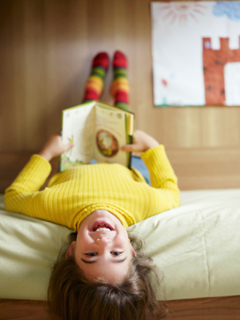Read this not that: my take on classic children’s books
Permanent link All Posts
Aside from having read children’s books to my younger sister and cousins, and then my own kids, I actually took a class in children’s literature in college, much to my parents’ joy. Also, there are tons of lists about which books to read to your kids, but no lists of the ones not to. I know for many of you Oy!sters, I’m probably ripping on some of your favorite childhood stories, but try to bear with me—I mean this all in good fun.
1. “Goodnight Moon” by Margaret Wise Brown
It starts off fine, with a list of things in a child’s room. Although, why a “great green room”? Aren’t kids’ bedrooms small and cozy? And is no one upset at the “mouse” loose in a baby’s room? If it’s a pet, why isn’t it caged? Anyway, the book has a simple task— relist all of these things and say goodnight to them to help a child ease from wakefulness to slumber. But it fails in this task. It adds things that were not listed at first: light, clocks, socks, stars, air, the Moon itself. It leaves out the telephone, the very first thing mentioned. It rhymes “Moon” with… “Moon.” It adds “Good night, nobody”— a blank page!— when there is not “nobody” there. In fact, there is a lady whispering “Hush,” who is then acknowledged. And why is there a “bowl of mush” in the bedroom? How many times do I have to say it: No food in the bedroom!
A better choice? “Goodnight, Gorilla,” by Peggy Rathmann
This adorable, mostly wordless book showcases a clever gorilla child who figures out how to sleep in a nice cozy human bed instead of his cage. It’s a good metaphor for kids who want to sleep in their parents’ bed, gently explaining they have beds of their own where they belong.
2. “Runaway Bunny” by Margaret Wise Brown
This time, she gives us a baby bunny who is trying to individuate and declare a sense of self, imagining himself running away. The mother bunny will not allow this liberty, even in the abstract. He is not even allowed to entertain the notion of freedom. No matter what form he changes himself into, she will change form to suit, in a way that captures him and brings him back. She does not say, “When you turn into a fish, where will you swim? What places do you want to see?” She says, “I will turn into a fisherman and catch you.” This fear/hatred of her child’s freedom is more than Big Brother-ish, which would imply endless watchfulness. No, this reminds me of the quote: “It can’t be bargained with. It can’t be reasoned with. It doesn't feel pity, or remorse, or fear. And it absolutely will not stop, ever.” Which is about The Terminator.
A better choice? “Blueberries for Sal” by Robert McCloskey
A mother and daughter go blueberry picking on a lovely day. Also, a mother bear and her cub. The children end up getting separated, with each unwittingly following the wrong parent. The resolution is handled with care, and children learn not to stray… but that if they do, their parents will find them.
3. “Guess How Much I Love You?” by Sam McBratney
More parent-child bunny dysfunctionality. This time Little Nutbrown Hare (is “nutbrown” even a color?) declares his love for Big Nutbrown Hare with expressions like, “I love you how high I can jump!” Does the parent hare say, “Aww, how sweet! Thank you, baby!” Or “What a clever way to say how much you love me! I love you, too.” Nope! He says “I love you how high I can jump!” Which, as is he is Big, is much, much higher. In fact, the entire book consists of the adult one-upping the child with his superior, adult-level size, strength, and wit. But why the competition? Why insist that his child fall short, and must love him less, simply because he is smaller? Can’t a Little creature love as largely as a Big one? And wouldn’t that be a better book— “I can love you, Parent, just as much as you love me… even though I am not as big!”
A better choice? “Pat the Bunny” by Dorothy Kunhardt
While the baby interacts with the pages, she also relates to her parents. Daddy has a scratchy face! Mommy’s ring is too big! There is a sense of warmth, closeness, and playfulness. No one is better or worse—everyone does what they can do, and that’s wonderful.
4. “Love You Forever” by Robert Munsch
This one truly makes me ill. A mother holds her baby son and tells him: “I love you forever. I love you for always. As long as you’re living, my baby you’ll be.” Aww! But then she keeps doing this as he grows up. He’s a kid, he’s a teenager, he’s a young adult. Still, she cradles him in his sleep and tells him this. Then he’s a grown man, and he moves into a house across town. So she’s done, right? Nope! She drives over in the middle of the night. She breaks into his house, sits on his bed, cradles him in his sleep, and tells him, “As long as you’re living, my baby you’ll be.” At which point, he wakes up and screams, “Leave me alone, you psycho! Why do you think I moved across town? Why do you think I never got married? Do you know how high my analysis bills are?!” Except… he doesn’t. It is too late for him and he’s doomed. She eventually grows too old for this ritual. So now he drives over to her place in the middle of the night, holds her, and tells her, “As long as you’re living, my mommy you’ll be.” Now just look what you did… you made Dr. Freud cry!
A better choice? “Counting Kisses” by Karen Katz
Books on letters, numbers, colors, shapes, and objects abound. But along with “counting,” this book teaches the members of the family and parts of the body, basic elements of a baby’s world… and ones that are arguably more important than animal sounds. Everyone gets a turn to kiss the baby goodnight until she is all kissed out.
5. “The Giving Tree” by Shel Silverstein
This should not be read to children. This should be handed out to members of Codependence Anonymous as a case study. It’s about a tree who loves a boy. He eats her apples and plays in her branches. Then he grows up, gets married… and builds a house out of those branches. Then he retires and cuts her down to make a canoe out of her trunk. When he is ready to die, he comes and sits on the stump, which is all she had left. And no matter how much he uses her, how much he takes, how little (actually nothing) he gives back, she loves him! Because that’s who she is. The one thing he’s made from her from the start is a doormat. If this is supposed to be the model for a parent, we’re going to have a whole lot of bratty, take-y kids running around. Oh, wait.
A better choice? Anything else by Shel Silverstein
Silverstein’s books of poetry-plus-cartoons for kids are the best since Dr. Seuss’. It’s just a shame that “Giving Tree” has become so popular, while better storybooks of Shel’s like the “Missing Piece Meets the Big O” and “Lafcadio, The Lion Who Shot Back,” are less well-known.
Year after year, these same books get trotted out as “best for babies.” Yet how many adults have examined them with a critical eye, and noticed what messages we are really sending kids when we read them? Some of the best-loved books of baby-dom are, in fact, teaching our kids all the wrong things.



.jpg)



